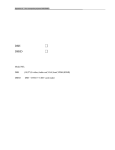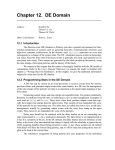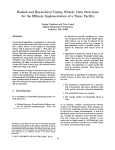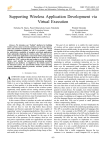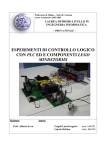Download User's guide to javaSimulation
Transcript
User’s guide to javaSimulation
1. Introduction
This guide describes javaSimulation , a Java package for process-based
discrete event simulation. The package is a Java implementation of the simulation facilities provided by SIMULA [1][2][3]. In addition to the simulation
facilities, the package also includes the facilities for list manipulation, random
number drawing and coroutine sequencing as found in SIMULA.
A simulation encompasses a set of interacting processes. A process is an object associated with a sequence of activities ordered logically in simulated
time. Each process has its own life cycle and may undergo active and inactive
phases during its lifetime. Processes represent the active entities in the real
world, e.g., customers in a supermarket.
In JavaSimulation the processes are described in one or more subclasses
of the class Process . Their life cycles are described by overriding the abstract method actions .
class Customer extends Process {
public void actions() {
// The life cycle of a customer
}
}
An outline of class Process is shown below.
public abstract class Process extends Link {
protected abstract void actions();
public
public
public
public
public
static
static
static
static
static
double time();
void activate(Process p);
void hold(double t);
void passivate();
void wait(Head q);
}
1
The time method returns the current simulated time.
The activate method is used to make a specified process start executing its
actions.
The hold method suspends the execution of the calling process for a specified period of time.
The passivate method suspends the execution of the calling process for an
unknown period of time. Its execution may later be resumed by calling
activate with the process as argument.
Since class Process is a subclass of the class Link , each process has the
capability of being a member of a queue. The wait method suspends the
calling process and adds it to a queue.
The use of these facilities is best explained through an example. The figure
below shows the system to be simulated.
.
.
.
Customer
generator
Queue
Servers
It is an abstraction of, for example, a bank where the customers wait in a single queue for any of the tellers.
The interval between arrivals is uniformly distributed from 1 to 3 minutes.
The time for serving a customer is normally distributed with a mean value of
4 minutes and a standard deviation of 1 minute. Simulation is used to find the
average time a customer spends in the system.
First the processes of the system are identified.
One process is the generator of customers. It should repeatedly generate a
customer and wait a period of time.
Customers and servers may also be conceived as processes. When a customer
arrives, he activates an idle server (if any) and then waits in the queue. An
active server repeatedly serves customers from the queue until the queue is
empty. Then the server passivates.
2
Using the javaSimulation package this model may be described by the
following three classes:
class CustomerGenerator extends Process {
public void actions() {
while (true) {
activate(new Customer());
hold(random.uniform(1, 3));
}
}
}
class Customer extends Process {
public void actions() {
double arrivalTime = time();
into(customerQueue);
if (!serverQueue.empty())
activate((Process)
serverQueue.first());
passivate();
customers++;
throughTime += time() - arrivalTime;
}
}
class Server extends Process {
public void actions() {
while (true) {
out();
while (!customerQueue.empty()) {
Customer served =
(Customer) customerQueue.first();
served.out();
hold(random.normal(4, 1));
activate(served);
}
wait(serverQueue);
}
}
}
Customers wait in a queue called customerQueue . When a server activates
a customer after the completion of a service, the customer just updates statistics and terminates.
Idle servers wait in a queue called serverQueue . When a customer activates an idle server, the server leaves this queue and serves the customer.
3
A complete program for simulating the system is shown below. The classes
CustomerGenerator , Customer and Server are as defined above.
import javaSimulation.*;
import javaSimulation.Process;
public class Simulation extends Process {
int servers = 2;
Random random = new Random(7913);
Head customerQueue = new Head();
Head serverQueue = new Head();
int customers;
double throughTime;
public void actions() {
for (int i = 1; i <= servers; i++)
new Server().into(serverQueue);
activate(new CustomerGenerator());
hold(600);
System.out.println(throughTime/customers);
}
class CustomerGenerator extends Process { ... }
class Customer extends Process { ... }
class Server extends Process { ... }
public static void main(String args[]) {
activate(new Simulation());
}
}
This program simulates a system with two servers over a period of 600 minutes.
The main method starts the simulation by activating an object of a
Process -derived class. This object is called the main process and acts as
main program for the simulation. The simulation stops when the main process
terminates.
In this program the main process inserts a number of servers in the queue of
idle servers, activates the customer generator and waits 600 units of simulated
time. Before it terminates, it prints the average time spent by customers in the
system.
4
The program imports all classes of the javaSimulation package. Note,
however, that class Process must be imported explicitly in order to avoid
the name conflict caused by the co-existence of the class Process of the
java.lang package.
The simulation above is based on active customers and active servers. A
model based on active customers and passive servers may be obtained by defining the classes Customer and Server as follows:
class Customer extends Process {
public void actions() {
double arrivalTime = time();
if (serverQueue.empty()) {
wait(customerQueue);
out();
}
Server server = (Server) serverQueue.first();
server.out();
hold(random.normal(4, 1));
server.into(serverQueue);
if (!customerQueue.empty())
activate((Customer) customerQueue.first());
customers++;
throughTime += time() - arrivalTime;
}
}
class Server extends Link {}
5
A model based on passive customers and active serves may be obtained by
defining the CustomerGenerator , Customer and Server classes as
follows:
class CustomerGenerator extends Process {
public void actions() {
while (true) {
new Customer().into(customerQueue);
if (!serverQueue.empty())
activate((Server) serverQueue.first());
hold(random.uniform(1, 3));
}
}
}
class Server extends Process {
public void actions() {
while (true) {
out();
while (!customerQueue.empty())
Customer served =
(Customer) customerQueue.first();
served.out();
hold(random.normal(4, 1));
customers++;
throughTime += time() - served.arrivalTime;
}
wait(serverQueue);
}
}
}
class Customer extends Link {
double arrivalTime = time();
}
All three versions produce the same output (in less than a second):
11.79438522339415
However, the last version executes faster than the two other versions. This is
due to the computational overhead induced by the usage of threads internally
in javaSimulation . Each Process has its actions executed by a
thread. In contrast to the two first versions, the last version has a small number of processes. In this version there are only three processes (the main
process and the two server processes).
6
2. The simulation facilities of javaSimulation
The design of the javaSimulation package follows very closely the design of the built-in package for discrete event simulation in SIMULA, class
SIMULATION. The development of javaSimulation has been described
in [4].
A program is composed of a set of processes that undergo scheduled and unscheduled phases. When a process is scheduled, it has an event time associated with it. This is the time at which its next active phase is scheduled to occur. When the active phase of a process ends, it may be rescheduled, or
descheduled (either because all its actions have been executed, or the time of
its next active phase is not known). In either case, the scheduled process with
the smallest event time is resumed.
The currently active process always has the smallest event time associated
with it. This time, the simulation time, moves in jumps to the event time of
the next scheduled process.
Scheduled events are contained in an event list. The processes are ordered in
accordance with increasing event times. The process at the front of the event
list is always the one, which is active. Processes not in the event list are either
terminated or passive.
At any point in simulation time, a process can be in one (and only one) of the
following four states:
(1) active: the process is at the front of the event list. Its actions are being
executed
(2) suspended: the process is in the event list, but not at the front
(3) passive: the process is not in the event list and has further actions to
execute
(4) terminated: the process is not in the event list and has no further actions
to execute.
7
All the public parts of the Process class are shown in the class outline below.
public abstract class Process extends Link {
protected abstract void actions();
public
public
public
public
public
public
static
static
static
static
static
static
final
final
final
final
final
final
Process current();
double time();
void hold(double t);
void wait(Head q);
void cancel(Process p);
Process main();
public
public
public
public
public
static
static
static
static
static
final
final
final
final
final
At
Delay
Before
After
Prior
at;
delay;
before;
after;
prior;
public static final void activate(Process p);
public static final void activate(Process p,
At at, double t);
public static final void activate(Process p,
Delay delay, double t);
public static final void activate(Process p,
At at, double t, Prior prior);
public static final void activate(Process p,
Delay d, double t, Prior prior);
public static final void activate(Process p1,
Before before, Process p2);
public static final void activate(Process p1,
After after, Process p2);
public static final void reactivate(Process p);
public static final void reactivate(Process p,
At at, double t);
public static final void reactivate(Process p,
Delay delay, double t);
public static final void reactivate(Process p,
At at, double t, Prior prior);
public static final void reactivate(Process p,
Delay d, double t, Prior prior);
public static final void reactivate(Process p1,
Before before, Process p2);
public static final void reactivate(Process p1,
After after, Process p2);
public
public
public
public
final
final
final
final
boolean idle();
boolean terminated();
double evTime();
Process nextEv();
}
8
Below is given a short description of each of the methods.
current() returns a reference to the Process object at the
front of the event list (the currently active process).
time() returns the current simulation time.
hold(t) schedules Current for reactivation at time() + t .
passivate() removes current() from the event list and resumes the actions of the new current() .
wait(q) includes current() into the two-way list q , and then
calls passivate() .
cancel(p) removes the process p from the event list. If p is
currently active or suspended, it becomes passive. If p is a passive
or terminated process or null , the call has no effect.
It is desirable to have the main program participating in the simulation as a
process. This is achieved by an impersonating Process object that can be
manipulated like any other Process object. This object, called the main
process, is the first process activated in a simulation.
main() returns a reference to the main process.
There are seven ways to activate a currently passive process:
activate(p) : activates process p at the current simulation time.
activate(p1, before, p2) : positions process p1 in the
event list before process p2 , and gives it the same event time as
p2 .
activate(p1, after, p2) : positions process p1 in the event
list after process p2 , and gives it the same event time as p2 .
activate(p, at, t) : the process p is inserted into the event
list at the position corresponding to the event time specified by t .
The process is inserted after any processes with the same event
time which may already be present in the list.
activate(p, at, t, prior) : the process p is inserted into
the event list at the position corresponding to the event time specified by t . The process is inserted before any processes with the
same event time which may already be present in the list.
9
activate(p, delay, t) : the process p is activated after a
specified delay, t . The process is inserted in the event list with the
new event time, and after any processes with the same simulation
time which may already be present in the list.
activate(p, delay, t, prior) : the process p is activated
after a specified delay, t . The process is inserted in the event list
with the new event time, and before any processes with the same
simulation time which may already be present in the list.
Correspondingly, there are seven reactivate methods, which work on
either active, suspended or passive processes. They have similar signatures to
their activate counterparts and work in the same way.
All methods described above are class methods of class Process . The following four instance methods are available:
idle() returns true if the process is not currently in the event
list. Otherwise false .
terminated() returns true if the process has executed all its
actions. Otherwise false .
evTime() returns the time at which the process is scheduled for
activation. A runtime exception is thrown if the process is not
scheduled.
nextEv() returns a reference to the next process, if any, in the
event list.
10
3. The list handing facilities of javaSimulation
This package contains facilities for the manipulation of two-way linked lists.
Its functionality corresponds closely to SIMULA's built-in class SIMSET.
List members are objects of subclasses of the class Link .
An object of the class Head is used to represent a list.
The class Linkage is a common superclass for class Link and class Head .
The three classes are described below by means of the following variables:
Head hd;
Link lk;
Linkage lg;
Class Linkage
public class Linkage {
public final Link pred();
public final Link suc();
public final Linkage prev();
}
lk.suc()
returns a reference to the list member that is the successor
of lk if lk is a list member and is not the last member of
the list; otherwise null .
hd.suc()
returns a reference to the fist member of the list hd, if the
list is not empty; otherwise null .
lk.pred()
returns a reference to the list element that is the predecessor of lk if lk is a list member and is not the first member of the list; otherwise null .
hd.pred()
returns a reference to the last member of the list hd if the
list is not empty; otherwise null .
lk.prev()
returns null if lk is not a list member, a reference to the
list head if lk is the first member of a list; otherwise a reference to lk 's predecessor in the list.
hd.prev()
returns a reference to hd if hd is empty; otherwise a reference to the last member of the list.
11
Class Head
public class Head extends Linkage {
public final Link first();
public final Link last();
public final boolean empty();
public final int cardinal();
public final void clear();
}
hd.first()
returns a reference to the first member of the list (null ,
if the list is empty).
hd.last()
returns a reference to the last member of the list (null , if
the list is empty).
hd.cardinal() returns the number of members in the list (null , if the
list is empty).
hd.empty()
returns true if the list hd has no members; otherwise
null .
hd.clear()
removes all members from the list.
12
Class Link
public class Link extends Linkage {
public final void out();
public final void follow(Linkage ptr);
public final void precede(Linkage ptr);
public final void into(Head s);
}
lk.out()
removes lk from the list (if any) of which it is a member. The call has no effect if lk has no membership.
lk.into(hd)
removes lk from the list (if any) of which it is a member and inserts lk as the last member of the list hd .
lk.precede(lg) removes lk from the list (if any) of which it is a member and inserts lk before lg . The effect is the same as
lk.out() if lg is null , or it has no membership
and is not a list head.
lk.follow(lg)
removes lk from the list (if any) of which it is a member and inserts lk after lg . The effect is the same as
lk.out() if lg is null , or it has no membership
and is not a list head.
13
4. The random drawing facilities of javaSimulation
The javaSimulation package provides the same methods for random
drawing as can be found in SIMULA. All methods are available in a class
called Random . A summary of this class is shown below.
public class Random extends java.util.Random {
public Random() { super(); }
public Random(long seed) { super(seed); }
public
public
public
public
public
public
public
public
public
public
final
final
final
final
final
final
final
final
final
final
boolean draw(double a);
int randInt(int a, int b);
double uniform(double a, double b);
double normal(double a, double b);
double negexp(double a);
int poisson(double a);
double erlang(double a, double b);
int discrete(double[] a);
double linear(double[] a, double[] b);
int histd(double[] a);
}
The class is an extension of Java’s standard class java.util.Random .
Thus, all of the facilities of the latter class is also available to the user.
public Random();
This constructor creates a Random object with the current time as its
seed value.
public Random(long seed);
This constructor creates a Random object with the given seed value.
14
Each of the instance methods performs a random drawing of some kind.
Their semantics are as in SIMULA.
boolean draw(double a);
The value is true with the probability a , false with probability 1-a .
It is always true if a ≥ 1 , and always false if a ≤ 0 .
int randInt(int a, int b);
The value is one of the integers a , a+1 , …, b-1 , b with equal probability. If b < a , the call constitutes an error.
double uniform(double a, double b);
The value is uniformly distributed in the interval a ≤ x < b . If b ≤ a ,
the call constitutes an error.
double normal(double a, double b);
The value is normally distributed with mean a and standard deviation
b.
double negexp(double a);
The value is a drawing from the negative exponential distribution with
mean 1 /A . If a is non-positive, a runtime error occurs.
int poisson(double a);
The value is a drawing from the Poisson distribution with parameter
a.
double erlang(double a, double b);
The value is a drawing form the Erlang distribution with mean 1 /a
and standard deviation 1 /(a * √b) . Both a and b must be positive.
15
int discrete(double[] a);
The one-dimensional array a of n elements of type double , augmented by the element 1 to the right, is interpreted as a step function
of the subscript, defining a discrete (cumulative) distribution function.
The function value satisfies
0 ≤ discrete(a) ≤ n
It is defined as the smallest i such that a [i ] > r , where r is a random
number in the interval [0 ;1 ] and a [n] = 1 .
double linear(double[] a, double[] b);
The value is a drawing from a (cumulative) distribution function f,
which is obtained by linear interpolation in a non-equidistant table defined by a and b , such that a [i ] = f(b [i ]).
It is assumed that a and b are one-dimensional arrays of the same
length, that the first and last elements of a are equal to 0 and 1 , respectively, and that a [i ] ≥ a [j ] and b [i ] > b [j ] for i > j .
public int histd(double[] a);
The value is an integer in the range [0 ;n-1 ] where n is the number of
elements in the one-dimensional array a . The latter is interpreted as a
histogram defining the relative frequencies of the values.
16
References
1. O.-J. Dahl, B. Myhrhaug & K. Nygaard,
Common Base Lanugae,
NNC Publication S-22 (1970).
2. G. M. Birtwistle, O.-J. Dahl, B. Myhrhaug & K. Nygaard,
SIMULA BEGIN,
Studentlitteratur (1974).
3. Programspråk – SIMULA, SIS,
Svensk Standard SS 63 61 14 (1987).
4. K. Helsgaun,
Discrete Event Simulation in Java,
Datalogiske skrifter, No. 89, Roskilde University (2000).
17





















